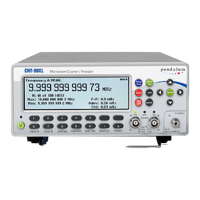Interface Functions
What can I do with the Bus?
All the capabilities of the interface for the
'9X' are explained below.
n
Summary
Description, Code
Source handshake, SH1
Acceptor handshake, AH1
Control function, C0
Talker Function, T6
Listener function, L4
Service request, SR1
Remote/local function, RL1
Parallel poll, PP0
Device clear function, DC1
Device trigger function, DT1
Bus drivers, E2
n
SH1 and AH1
These simply mean that the counter can
exchange data with other instruments or a
controller using the bus handshake lines:
DAV, NRFD, NADC.
n
Control Function, C0
The counter does not function as a con
-
troller.
n
Talker Function, T6
The counter can send responses and the
results of its measurements to other de
-
vices or to the controller. T6 means that it
has the following functions:
–
Basic talker.
–
No talker only.
–
It can send out a status byte as response to
a serial poll from the controller.
–
Automatic un-addressing as a talker when
it is addressed as a listener.
n
Listener Function, L4
The counter can receive programming in
-
structions from the controller. L4 means
that it has the following functions:
–
Basic listener.
–
No listen only.
–
Automatic un-addressing as listener when
addressed as a talker.
n
Service Request, SR1
The counter can call for attention from
the controller, e.g., when a measurement
is completed and a result is available.
n
Remote/Local, RL1
You can control the counter manually
(locally) from the front panel or remotely
from the controller. The LLO, lo
-
cal-lock-out function, can disable the LO
-
CAL button on the front panel.
n
Parallel Poll, PP0
The counter does not have any parallel
poll facility.
n
Device Clear, DC1
The controller can reset the counter via
interface message DCL (Device clear) or
SDC (Selective Device Clear).
Getting Started
Interface Functions 1-5

